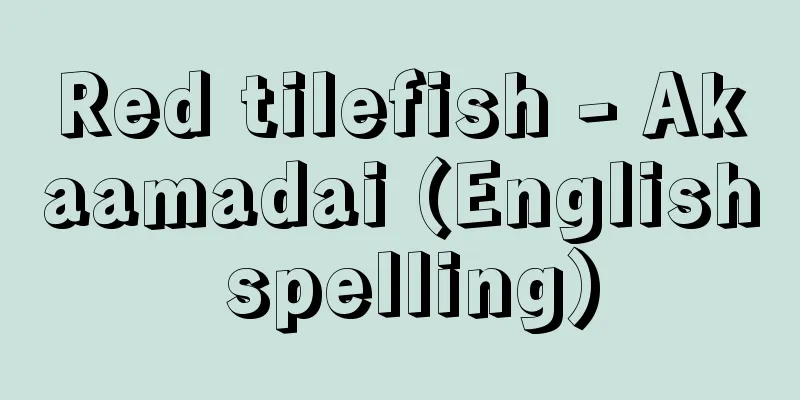Red tilefish - Akaamadai (English spelling)

|
A marine fish belonging to the order Perciformes, family Amadai. It is the most common species of tilefish found in Japan, and is also known as amadai. In Osaka, it is called kuzuna, in Kyoto, and okitsudai in Shizuoka. It is distributed along the Pacific coast from Ibaraki Prefecture to the southern coast of Kyushu, along the Sea of Japan coast from Aomori Prefecture to the western coast of Kyushu, in the East China Sea, northern Taiwan, the Yellow Sea, and the South China Sea. The body is elongated and laterally compressed. The body length is 3.7 to 4.0 times the body height. The head is large, and the body length is 3.2 to 3.4 times the head length. The outer contour of the head is steeply inclined. The upper and lower jaws are almost horizontal or slightly inclined, and the rear end of the upper jaw reaches below the anterior third of the pupil. The upper jaw has curved conical teeth in two to three rows in the front and one row in the back. The lower jaw has conical teeth that become a wide band of teeth at the front. The vomer (the bone at the front of the skull floor) and palate are toothless. The angle between the vertical and horizontal parts of the preopercle is 90-95 degrees, and there is no notch in the angle. There are 8-9 gill rakers on the upper branch and 14-15 on the lower branch. The head and body are covered with pectinate scales, and the scales on the cheeks are buried under the skin and indistinct. The number of lateral line scales is 45-53. The dorsal and anal fins have long bases and no notch between the spines and soft rays. Its dorsal fin has 7 spines and 15 soft rays, its anal fin has 2 spines and 11 to 12 soft rays, and its pectoral fin has 18 to 19 soft rays. Its body is pink-red with several orange-yellow horizontal bands on the sides of its central part. Behind its eyes there is a triangular silvery-white spot pointing downward. A thin dark brown line runs along the midline of its back from the origin of its dorsal fin to the upper rear edge of its pupil. The upper lobe of its caudal fin has 5 to 6 yellow vertical bands, below which it is uniformly gray-blue. It lives on muddy bottoms and sandy bottoms mixed with shells and mud at depths of 60 to 300 meters, mostly 75 to 130 meters, and feeds on shrimp, mantis shrimp, fish, crabs, polychaetes, bivalves, etc. Spawning occurs from early summer to late autumn near the shore at depths of 70 to 100 meters, with larger fish spawning earlier than smaller fish. Sex ratio varies with body length, with more females at 12 to 26 centimeters, more males at 27 centimeters, and mostly males at 32 centimeters and above. Eggs are detached and pelagic, with a single oil globule, and are 0.8 to 1.1 millimeters in diameter. Hatched larvae are 2.05 millimeters long. At 6.5 millimeters long, the head is covered with numerous tiny spines, and several long spines have developed on the rear edge of the preopercle. No elongated fin rays are seen. The larvae float in a layer 10 to 50 meters deep for a while. When they reach a total length of 30 millimeters, most of the projections and tiny spines disappear. They grow to 16-19 cm in one year, 22-23 cm in two years, 25-26 cm in three years, and just over 30 cm in four years. Males can reach a maximum total length of 53 cm, and females 47 cm. They are caught by longline, bottom trawl, fishing, and rowing gill nets, but the catch is decreasing. They are in season in winter, and because their meat is white, tender, and tasty, they are treated as a luxury fish and are prepared in a variety of ways, including grilled with salt, pickled in sake lees, teriyaki, steamed, and dried. [Masao Katayama and Kunio Amanooka, December 11, 2020] [Reference item] |© Tadaaki Ohkata "> Main species of the family Acanthidae (specimen illustrations) ©Shogakukan "> Drying of red tilefish Source: Shogakukan Encyclopedia Nipponica About Encyclopedia Nipponica Information | Legend |
|
硬骨魚綱スズキ目アマダイ科に属する海水魚。日本産のアマダイ類中もっとも普通にみられる種で、別名はアマダイ。大阪ではクズナ、京都ではグジ、静岡ではオキツダイとよばれている。茨城県から九州の南岸の太平洋沿岸、青森県から九州西岸の日本海沿岸、東シナ海、台湾北部、黄海、南シナ海などに分布する。体は延長し、側扁(そくへん)する。体長は体高の3.7~4.0倍。頭は大きく、体長は頭長の3.2~3.4倍。頭部の外郭は急傾斜する。上下両顎(りょうがく)はほとんど水平か、わずかに斜めで、上顎の後端は瞳孔(どうこう)の前3分の1の下に達する。上顎には湾曲した円錐歯(えんすいし)があり、前方では2~3列で、後方では1列。下顎には円錐歯があり、前部では幅広い歯帯になる。鋤骨(じょこつ)(頭蓋(とうがい)床の最前端にある骨)と口蓋骨には歯がない。前鰓蓋骨(ぜんさいがいこつ)の垂直部と水平部の角度は90~95度で、隅角(ぐうかく)部に切れ込みがない。鰓耙(さいは)は上枝に8~9本、下枝に14~15本。頭と体は櫛鱗(しつりん)をかぶり、頬(ほお)部の鱗(うろこ)は皮下に埋没して不明瞭(ふめいりょう)である。側線鱗数は45~53枚。背びれと臀(しり)びれは基底が長く、棘(きょく)部と軟条部の間に切れ込みがない。背びれは7棘15軟条、臀びれは2棘11~12軟条、胸びれは18~19軟条。体は桃赤色で、中央部の側面に数本の橙黄(とうこう)色の横帯がある。目の後方に下方に向かう三角形の銀白色の斑紋(はんもん)がある。背びれの起部から瞳孔(どうこう)の後縁上方までの背正中線上に暗褐色の細い線が走る。尾びれの上葉に5~6本の黄色の縦帯が走り、その下方は一様に灰青色である。水深60~300メートル、多くは75~130メートルの泥底、および貝殻や泥まじりの砂底にすみ、エビ類、シャコ類、魚類、カニ類、多毛類、二枚貝類などを食べる。 産卵は初夏から晩秋にかけて岸近くの水深70~100メートルで行い、その時期は大形魚が小形魚より早い。体長によって性比が異なり、12~26センチメートルでは雌が多いが、27センチメートルになると雄が多くなり、32センチメートル以上では雄ばかりになる。卵は1個の油球をもつ分離浮性で、卵径は0.8~1.1ミリメートル。孵化仔魚(ふかしぎょ)は全長2.05ミリメートル。全長6.5ミリメートルの稚魚では頭部は多数の微小棘で覆われ、前鰓蓋骨の後縁に数本の長い棘が発達する。伸長した鰭条(きじょう)はみられない。稚魚はしばらくの間水深10~50メートルの層を浮遊している。全長30ミリメートルの大きさになると、突起や微小棘はほとんど消失する。1年で16~19センチメートル、2年で22~23センチメートル、3年で25~26センチメートル、4年で30センチメートルあまりに成長する。最大全長は雄では53センチメートル、雌では47センチメートルに達する。延縄(はえなわ)、底引網、釣り、漕(こ)ぎ刺網(さしあみ)などで漁獲されるが、漁獲量は減少傾向にある。旬は冬で、肉は白身で柔らかく、味がよいので高級魚として取り扱われ、塩焼き、粕(かす)漬け、照焼き、蒸し物、干物などにする。 [片山正夫・尼岡邦夫 2020年12月11日] [参照項目] |©大片忠明"> アマダイ科のおもな種類〔標本画〕 ©Shogakukan"> アカアマダイの開き干し 出典 小学館 日本大百科全書(ニッポニカ)日本大百科全書(ニッポニカ)について 情報 | 凡例 |
>>: Red-footed turtle - Red-footed turtle
Recommend
ESC - Electronic Storage Controller
《 electronic stability control 》⇒anti-skid device ...
Guanche people - Guanche people (English spelling)
The indigenous people of the western part of the C...
Lauraceae
...Cinnamon, which is used for medicinal purposes...
gamma
One of the constants that express the characteris...
Shimada Seijiro
Novelist. Born in Ishikawa Prefecture. Dropped ou...
Rengeji Temple Death Register - Rengeji Temple Death Register
A register of the deaths owned by Rengeji Temple i...
Fudai - Fudai
It is also written as Fudai. It is said to be one ...
Sei Shonagon
His birth and death years are unknown. He was a p...
ink
〘noun〙 (ink)⸨ink⸩ (During the Meiji period, "...
Uilta language - Uilta (English spelling)
The language of the Uilta, an ethnic minority liv...
Andrei Yur'evich Bogolyubskii
1111-74 Prince of Vladimir and Suzdal, Russia. Rei...
Pharmacy - yakkyoku
A pharmacy is a place where a pharmacist dispense...
Obi-go
...A castle town in Hyuga Province (Miyazaki Pref...
Occupational hygiene
Research and practical activities on ensuring the...
Katanga
…In the southeastern part of the Democratic Repub...

![Yuzawa [Hot Spring] - Yuzawa](/upload/images/67cd139d5b009.webp)


![Kagamino [town] - Kagamino](/upload/images/67cb2d4b5ce52.webp)


![Beppu [city] - Beppu](/upload/images/67ccc943a20a1.webp)

